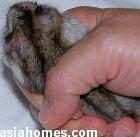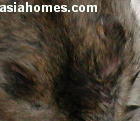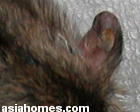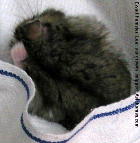 "My
daughter's hamster cannot open its left eye," Mrs Chan said. "Is it a
serious problem as my daughter is worried?" Mrs Chan's daughter was
distressed that the young hamster could not open its
eyes. "My
daughter's hamster cannot open its left eye," Mrs Chan said. "Is it a
serious problem as my daughter is worried?" Mrs Chan's daughter was
distressed that the young hamster could not open its
eyes.
This was October and many mothers had taken leave from work to
coach or supervise their children for the crucial Primary Six Leaving Examination
(PSLE).
Top secondary schools accept students with PSLE score of at least
260 marks and all mothers hope that their children will qualify
for a better future. They fear that poor grades will mean an
extra year to the
four years of Secondary education.
"I can't
diagnose over the telephone," I said. "What you describe
appears to be the sticky pus formed at the eyes had
glued up the eyelids. This is a common complaint of sick hamster
cases seen at the veterinary surgery and is an indication of
something not right with the health of the
hamster."
"I should have brought three hamsters instead of two this
morning," time-pressed Mrs Chan lamented. "My husband
said two would be sufficient." I could understand the
need to contain expenses as Singapore was in a deep
recession. The additional hamster
would incur additional veterinary cost and every dollar counted. Mrs
Chan's
daughter had to stay at home to study and was not allowed to be at
the veterinary surgery.
What should Mrs Chan do? If she did not seek veterinary attention,
the hamster might die of septicemia or toxins in the blood. Her
daughter would not be able to concentrate on her revisions and the
examinations next week.
The two hamsters treated earlier for skin itchiness had cost her
forty dollars. "It would be cheaper to buy new
hamsters," Mrs Chan commented pragmatically to me.
It was a 10-minute taxi ride to the veterinary surgery and this
would have cost her ten dollars in taxi fare one way.
The dwarf
hamster was busy grooming itself. It was a ball of motion
and did not bite. Well, I could not trust dwarf hamsters not to
bite strangers. I wiped away the sticky pus from the left eyelid.
The eye was now visible. Clear of infection. A simple case of
purulent conjunctivitis, I thought. It was hard to stop this
active hamster to really examine it.
Now, there was a small patch of hair loss and redness below the
ear opening. It was not normal. A tell-tale sign of the hamster
scratching this ear several times traumatising the skin. Did the
hamster have ear mites? Ear infection? Wood shavings
fell into the ear canal causing itchiness?
Mrs Chan
immobilised the hamster in her hand for me to examine. It
was always wise for the veterinarian to let the owner handle the
hamster. The hamster would feel comfortable and would not bite the
owner.
Then I saw it. A flat ovoid-shaped 'tick' stuck on the flat side
of the inside of the ear at one end. It looked very much like the young dog tick
in shape. Yet it was very flat and was of the wrong colour.
Well, it could be a dog's tick finding a new host. Yet the dog's
tick does not like non canine blood. Was it matted hair in a
clump? No, it was more solid than that. More like a seed in
shape. Every day
brings in some new challenges for the veterinarian.
 I
used a pair of forceps to pull out the 'tick'. The hamster
shrieked. A high pitched "eek" sound of pain punctured
our concentration. I had never attempted to pull out a 'tick' from
a hamster and did not expect this shrill scream of pain. I
used a pair of forceps to pull out the 'tick'. The hamster
shrieked. A high pitched "eek" sound of pain punctured
our concentration. I had never attempted to pull out a 'tick' from
a hamster and did not expect this shrill scream of pain.
I released my forceps and the hamster scampered over to the edge
of the examination table. Mrs Chan quickly cupped it in her palm,
otherwise it would have fallen down the table.
I felt this flat seed-like structure with my thumb and forefinger
as best as I could. It was around 3 mm x 2 mm in diameter and was
small relatively to my hand. It was huge and troublesome to
the hamster.
It was not a 'tick' on closer examination. It
was a skin growth with a very short stalk. Too short to be seen
superficially in a whirling and twisting motion ball of fur.
Now, what should I do? Ideally, this hamster ought to be
anaesthesized and the growth clipped off surgically. It would cost
more. Mrs Chan had talked about the Prime Minister's comment
on quitters, the Singaporeans who emigrated for better future.
Life is expensive in Singapore. A Toyota Corolla cost about the
same as a big BMW or Mercedes in England or the U.S and houses are
much cheaper in these countries too. If she sells her property,
she will be comfortable financially in a new home such as
Australia.
"The recession had adversely affected many husbands, the heads of
house-hold recently," I said to Mrs Chan as I encountered
more of such clientele. "Many of them
are unemployed and would not take another job at a lower pay. The
recession meant that they would be paid less and had to work
longer hours and many of them just could not adapt to this
situation. Usually they had a working wife who was not happy with
a husband staying at home.
"However, there is a need to cut on expenses and the
treatment of two hamsters instead of three would save some
money." I explained to Mrs Chan although I did not know
whether her husband was in a distressed financial situation. Mrs Chan supported
my observations and said, "My friend wanted to divorce her
husband who had become unemployed and would d not get a steady job!"
"They may be senior managers or the humble chef, but they do
not want to be exploited and be paid less," I said. "Yet
no employer would pay them their old salaries and prefer to employ
younger people. Not those over forty years old and the men in this
age group are usually bread winners or heads of
house-holds."
Heads of house-hold are defined as the male breadwinner by the
Singapore Government and their dependents are entitled to medical
benefits. Therefore, female civil servants and those in some
Statutory Boards are not "heads of house-hold" and their
family do not qualify for medical benefits. In this way, the
Government appeared to prevent men from not shouldering their
responsibility by not working. This was sexism personified.
Well, a motherly love for her daughter's mental health had brought
this dwarf hamster here. It was trying to rub off its growth which
must be like a heavy weight around the small ear. The rubbing must
have caused more skin abrasions from the ear pinnae to the lower
part of the ear. The frequent motions of the left paw scratched
the eye-lids. The bacteria colonised the traumatised eye lids and
the body defence system brought in white blood cells to contain
the bacteria. Pus formed in sticky masses and glued up the upper
and lower eyelids.
What was the most economical procedure to remove this tumour?
General anaesthesia would be ideal but this was reality economics.
 Mrs
Chan could hold the hamster in her palm but then it might bite her
when I snipped the growth. I had to be precise. Cutting too low
would mean that the ear would be cut off or there would be a
gaping hole in the thin ear. There was no scope for error. If only
an additional thirty dollars for the anaesthesia was not a
problem. Mrs
Chan could hold the hamster in her palm but then it might bite her
when I snipped the growth. I had to be precise. Cutting too low
would mean that the ear would be cut off or there would be a
gaping hole in the thin ear. There was no scope for error. If only
an additional thirty dollars for the anaesthesia was not a
problem.
It was better to reduce cost so that the hamsters got treated.
However, lower costs could bankrupt the veterinary practice if the
revenue was not sufficient to cover the overheads in a recession
where fewer pets get treated.
I placed the hamster in the white "Good Morning" towel
commonly sold in Singapore and trapped the hamster in the
folds. Surprisingly, the hamster did not struggle or move.
As if, it felt secure and went to sleep. The towel did have fine
pockets of fibres and these might soothe this hamster into a
yoga-like trance. A type of contact hypnosis if there was such a
therapy.
I angled the curved tips of the operating scissors horizontally,
at the lowest end of the 'seed' but above the ear surface. There
was a short stalk, a very short one. There was only one
chance as the dazed hamster might just shoot off if I fiddled at
the base of the lump for more than one time. It was now or never.
I snipped at the spot where the 'seed' had a very short stalk
linked to the skin of the ear.
The blood oozed as the 'seed' flipped upwards and gravity pulled
down. It was not possible to see where it landed as the hamster
jerked sideways and kept rubbing its left ear with its left paw. I
pressed the towel against the small circular skin wound to stop
the minor bleeding. This was important as Mrs Chan would be
concerned about the care and handling of her
hamster.
The hamster moved immediately once I clipped off the growth with
my scissors. It must have felt the pain but did not
scream. with
my scissors. It must have felt the pain but did not
scream.
It saw this light brown 'seed' before I could locate it. Its front
paws grabbed
it in a wink of an eye and it went inside its pouches. I was
distracted by the need to stop the bleeding of the wound and had
not thought that this hamster would be presented with a 'seed'
just in front of its line of vision.
Mrs Chan held it while I used another forceps to open its mouth to get the 'seed'
out.
There was no way this hamster would oblige. Its eyeballs
popped out fully staring angrily at me, or so I thought. Its
tongue turned purplish in colour, as if it had become cyanotic. As
if it had difficulty in getting oxygen.
Would it die of stress? Birds are known to die at the hand of the
veterinarian when handled for injections and I did not want a dead
body here. The PSLE examinations meant a lot to Mrs Chan and pet
loss would stress her daughter.
It was extremely difficult to extract any seed from the pouch of
an active and objecting dwarf hamster which was already small in
the first place. I remembered Mrs Chan's daughter worrying about
this pet. I waved the white flag and surrendered to this hamster's
indignation of a human being trying to deprive her of her food.
"Better not to stress the hamster," I said to Mrs Chan
and she loosened her grip and let the hamster free.
I checked the dark red ear wound which was bleeding slightly from the wound on the skin surface.
I pressed the towel onto the wound for a few seconds. The bleeding stopped. The ear
flap was intact. If I had snipped a fraction of a mm deeper, the ear
flap would have a hole. This type of precision surgery I would
rather not perform any more, without anaesthesia to immoblise and
cut.
The hamster pawed its left ear but was otherwise happy that a burden
had been lifted off its 'shoulders', actually 'ear'.
Many Singaporean mothers will bear the burden when their children's pets fell
ill while fathers are busy working. Even when the children are grown
up adults. This bountiful motherly love ensures that the pets get
as well cared for as the progeny when they are sick or in
pain.
|